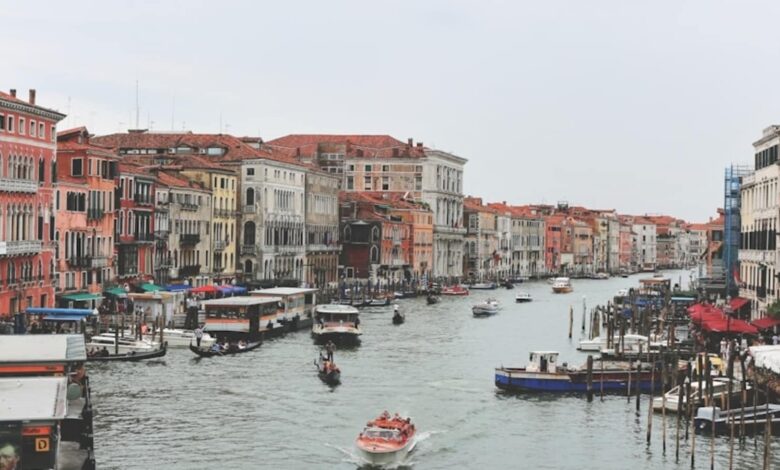9 gorgeous car-free cities around the world | Trending

In 2024, the number of cars in the world has grown to 1.475 billion – that’s one car for every 5.5 humans, or 182 per 1,000 humans. That number might seem innocuously gigantic until you hear of what they do to the planet – a typical passenger vehicle emits about 4.6 metric tons of carbon dioxide per year (Source: U.S. Environmental Protection Agency). Multiply that 4.6 metric tons 1.475 billion cars and the picture turns nightmarish. Venice, a UNESCO World Heritage Site that draws 20 million tours a year, is vehicle-free. What if we had no cars and we could live without traffic snarls and honking horns? That might now seem like an impossible dream but a few cities around the world have chosen to stay car-free every day. On World Car-free Day, let’s walk around a few car-free cities: Zermatt (Switzerland): Lying at the foot of Matterhorn, one of the world’s most photographed mountains, Zermatt has been car-free for as long as anyone can remember. For private vehicles, access is allowed until Täsch (5 kms from Zermatt). In Täsch, one changes to the shuttle train and travels to Zermatt (trains run every 20 minutes). You can get around foot, horse-drawn carriage, eTaxi, bike or mountain bike or free eBus (2 routes: skibus and Winkelmatten bus). La Digue Island (Seychelles): La Digue, a tiny dot in the Seychelles archipelago barely 45 minutes from the capital Mahé, is an island where nobody is in a hurry. No traffic snarls. No honking horns. Hop on a bike and take a lazy ride around the main road that loops around the island. Stop at Anse Source d’Argent, renowned as one of the most photographed beaches in the world. Trek to Anse Coco, grab a snorkel or a see-through kayak to check out the fish. And if you want to make some slow-moving friends, stop to feed the giant tortoises at La Union Estate, try the coconut wine while you are there! Those who prefer not to walk or have limited mobility, a few electric buggies are available as an alternative. Venice (Italy): Venice’s Centro Storico is often described as the Europe’s largest pedestrian-only urban space. Built on a group of 126 islands, Venice has over 400 staired bridges running over canals to connect each of the dricts. A UNESCO World Heritage Site that draws 20 million tours a year, Venice is vehicle-free. The Venetian once even planned to ban rolling suitcases! That’s how much they dislike wheels of any kind. Lamu (Kenya): Home to one of the oldest continuously inhabited Swahili towns, Lamu has banned cars. There are donkeys for land transport and dhows to travel throughout the archipelago. Now a UNESCO World Heritage Site, in the 1960s, the hippies tagged Lamu as Africa’s Kathmandu. Built in coral stone and mangrove timber, Lamu’s Old Town is characterised narrow streets and magnificent stone buildings with impressive curved doors, influenced unique fusion of Swahili, Arabic, Persian, Indian and European building styles. Fes el Bali (Morocco): Fes-al-Bali, the larger of the two medinas of Fes, is a nearly intact medieval city. With 13,380 horic buildings, the entire medina was designated a UNESCO World Heritage Site in 1981 and is probably the largest contiguous car-free area in the world. Some streets in Fes are as narrow as 24 inches and very few hit the 16 feet width mark. The streets are generally too narrow to even permit the use of bicycles, although there are a few areas in which bicycles and motor scooters are found. Ghent (Belgium): The city centre of Ghent, a university town famous for its medieval architecture and a row of guildhalls, has been car-free since 2017. Ghent has a free park-and-ride shuttle. In addition, the regular city bus routes, tram lines and even an electric boat ensure environmentally friendly mobility. Night buses and free transport for children up to the age of 14 make the local public transport even more attractive. Hydra (Greece): If you plan to head to the mountainous island of Hydra, leave your car – even bicycles – behind. Not only is this island car free, even bicycles are banned. So, how do you about the larinth of alleys? Walk, of course. But if you have wobbly knees, hop on the back of the island’s mules. Mules can be tardy but you’ll get used to their lumbering pace. Boats are best for the furthest beaches. Giethoorn (The Netherlands): Barely 75 miles from Amsterdam, Giethoorn has no cars. Not even tarred roads. The postcard-perfect hamlet known as the Dutch Venice can be navigated bike, boat, or foot through the footbridges crossing the maze of canals. Story is that the town got its name after its original farmer-settlers discovered a collection of wild-goat horns that they believed died in the Flood of 1170. Geytenhoren (goat horn) became Giethoorn later. Yelapa (Mexico): Literally, where two rivers meet the sea, Yelapa is nestled in the southernmost cove of the Bay of Banderas, the world’s seventh largest bay. There are no cars in Yelapa, although there is a road which leads to the outskirts of the village. The most widely used method of travel to and from the pueblo is boat. In the 1960s and 70s, hippies strung hammocks in open-air houses called palapas. “I’d rather have a palapa in Yelapa than a condo in Redondo” is still a common T-shirt slogan. Good to know: To learn more about car-free movement around the world, visit World Carfree Network the hub of the global car-free movement. Read Carbusters Online, their e-magazine.







